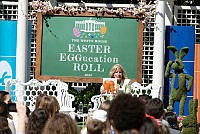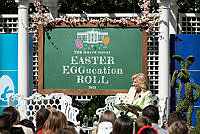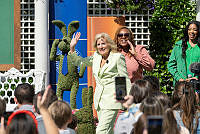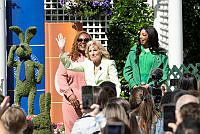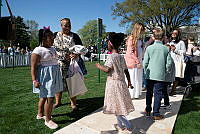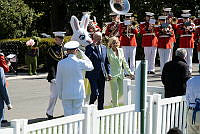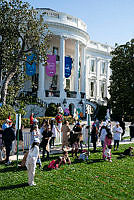Rubenstein Center Scholarship
Hoover Easter Egg Rolls

President Herbert Hoover stands on the South Portico to greet youngsters at the Easter egg roll on the White House South Lawn, April 21, 1930
Library of CongressThe annual White House Easter egg roll was a well-established tradition when President Herbert Hoover took office, and the Hoovers were present on April Fools’ Day, 1929 to observe their first Easter egg roll take place.
First Lady Lou Henry Hoover put her own imprint on the event by ordering part of the South Lawn roped off so maypole dances and Native American, Swedish and English folk dances could take place there. The dances were performed by the first lady’s favorite organization, the Girl Scouts, as well as the Girl Reserves of the Young Women’s Christian Association and members of Washington, D.C., private social service providers Friendship House and the Neighborhood House.
First Lady Lou Hoover watched the maypole dances and listened to glee club songs from the South Portico, where the president also appeared a few times to survey the children’s fun. Concerned that some children might not have eggs of their own, the president had chosen to have a crate of eggs presented to him by Governor Clyde M. Reed of Kansas hard-boiled and colored for distribution at the egg roll.

White House police officer B.B. Bradley rescues Gloria Largent, a lost child, at the Easter egg roll on April 21, 1930.
Library of CongressWhite House Police estimated that 47,217 people filled the South Lawn under gray, drab skies that soon became sunny. The police said that 71 children were lost but all were reunited with their parents by the time the egg roll ended at 6:00 p.m.1
The April 21, 1930 crowd of 48,464 set a then-record for White House Easter Egg Rolls. First Lady Lou Hoover decided to use the Rose Garden as a “lost and found bureau” where gone-astray children could be brought to their parents with the help of Girl Scout volunteers. Unfortunately the first lady had to watch the festivities from her bedroom window, as she was suffering from a bad cold and a sprained back.2
Cold winds and sprinkles of rain kept the 1931 Easter egg roll crowd down to an estimated 30,847. “Oh, look at this old rain,” First Lady Lou Hoover observed. “We had hoped there would be lots of sunshine.” Throughout the morning she called out, “Welcome!” and “Glad to see you!” from the South Portico. Inside the White House, the Hoovers’ grandchildren Peggy Ann (age 6) and Herbert (Pete) Hoover II (age 3) hosted an ice cream and cake Easter party of their own for the children of cabinet members, senators, representatives and executive department heads. They then went with their grandmother on an outing to the South Lawn to watch the excitement there, and President Hoover also emerged on to the South Portico to wish everyone well. Ten-year old Samuel Jackson of Muskegon, Michigan, was so excited to see the president that he slipped on the soggy grass and broke his arm. He was taken to the hospital, where he received flowers from the Hoovers and an invitation from the first lady to visit the White House.3

The Easter egg roll crowd gathered on the South Lawn with the South Lawn fountain and Washington Monument in the background, April 21, 1930.
Library of CongressDrizzly, rainy weather and temperatures in the upper 30s curbed attendance at what would prove to be the Hoover’s final Easter egg roll in 1932. Gloves, rubber overshoes and umbrellas were the order of the day. It was so chilly that the folk dances were canceled and instead the YWCA Girl Reserves dressed as animals, clowns and other circus entertainers for a spectacle performance on the driveway in front of the South Portico. Some of the children were seen blowing on their fingers to keep warm. Spirits revived, however, when First Lady Lou Hoover emerged to distribute Easter eggs carried in baskets by members of the White House domestic staff. One child was so keen to get an egg that she went through the line twice. “I’m sure I haven’t seen this Little Red Riding Hood before,” First Lady Lou Hoover told her, “so here’s a nice red egg for you.”
A highlight of the 1932 egg roll was the introduction of rubber Easter eggs, brightly painted to look like the real thing. The rubber eggs bounced on the grass and sidewalks to the enchantment of the children. “There are lot of ‘em around here today,” explained one boy, “because they roll better.”4






















